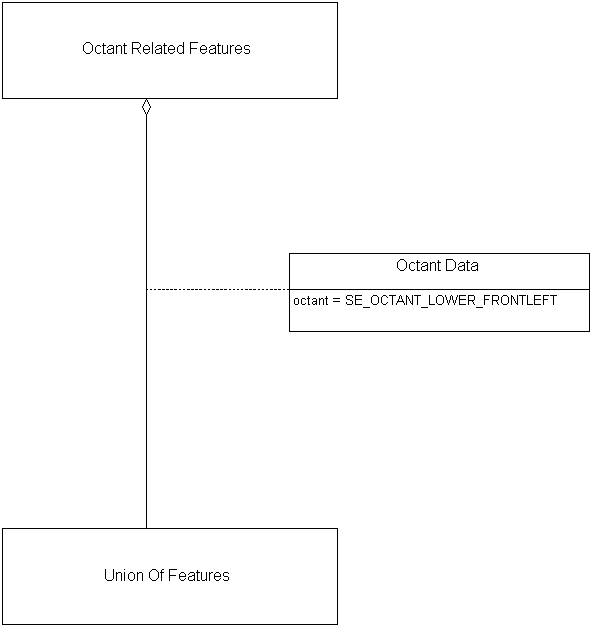Consider an Octtree that is represented in a transmittal by an <Octant Related Features> instance. The lower left octant of the octree is a <Union Of Features> aggregated by the <Octant Related Features> as follows:

|
The SEDRIS Data Representation Model
APPENDIX A - Classes Octant Related Features |
|---|
An instance of this DRM class specifies an aggregation of <Feature Hierarchy> instances in which each component <Feature Hierarchy> represents a branch of an octant. The octant represented by a branch is specified by the <Octant Data> instance associated with that branch. The bounding region that the <Feature Hierarchy> components occupy is defined by the <Spatial Extent> component of the <Octant Related Features> instance.
Consider an Octtree that is represented in a transmittal by an <Octant Related Features> instance. The lower left octant of the octree is a <Union Of Features> aggregated by the <Octant Related Features> as follows:

An <Octant Related Features> is used when an object in the hierarchy contains spatial components that occupy a certain octant. These octants might not contain <Primitive Features>, which is why this class can have less than 8 components.
<Octant Related Features> automatically has a <Spatial Extent> component, because it is a <Feature Hierarchy>. However, unlike other classes descended from <Feature Hierarchy>, <Octant Related Features> has a constraint stating that the <Spatial Extent> component is mandatory.
| SE_Boolean | unique_descendants; | (notes) |
|---|---|---|
| SE_Boolean | strict_organizing_principle; | (notes) |
An association between two <Feature Representation> instances indicates that the environmental object(s) that they represent have the semantic relationship indicated by the <Base Association Data> instance on the association relationship.
An association between a <Geometry Hierarchy> instance and a <Feature Representation> instance indicates that the environmental object(s) that they represent have the semantic relationship indicated by the <Base Association Data> instance on the association relationship.
An association between a <Property Grid> instance and a <Feature Representation> instance indicates that the environmental object(s) represented by the <Feature Representation> instance and the <Property Grid> instance (or some specific cell data within that <Property Grid> instance) have the semantic relationship indicated by the <Base Association Data> instance on the association relationship. Each associated <Property Grid> instance will indicate whether the entire <Property Grid> instance or only some specific cell data within it is participating in the relationship in question.
An association between two <Feature Representation> instances indicates that the environmental object(s) that they represent have the semantic relationship indicated by the <Base Association Data> instance on the association relationship.
An association between a <Geometry Hierarchy> instance and a <Feature Representation> instance indicates that the environmental object(s) that they represent have the semantic relationship indicated by the <Base Association Data> instance on the association relationship.
An association between a <Property Grid> instance and a <Feature Representation> instance indicates that the environmental object(s) represented by the <Feature Representation> instance and the <Property Grid> instance (or some specific cell data within that <Property Grid> instance) have the semantic relationship indicated by the <Base Association Data> instance on the association relationship. Each associated <Property Grid> instance will indicate whether the entire <Property Grid> instance or only some specific cell data within it is participating in the relationship in question.
This relationship exists to support *attributes for derived objects.* That is, these components are used only to specify texture mapping information for geometry that is to be derived from the <Aggregate Feature> by the consumer. These <Image Mapping Function> instances shall use <Image Anchor> components to specify the mapping.
A <Presentation Domain> component is needed for instances of <Aggregate Feature> that are significant only for a particular domain, such as radar.
If the value of the unique_descendants field is SE_TRUE, each descendant, that is, each <Feature Representation> instance that exists in the component tree rooted at the given <Aggregate Feature>, shall be unique, in the sense that it shall appear in only one branch of this aggregation. If unique_descendants is SE_FALSE, at least one <Feature Representation> instance appears in more than one branch of the aggregation.
If the value of the strict_organizing_principle field is SE_TRUE, each branch of this aggregation strictly complies with the organizing principle for its particular subclass. If this value is SE_FALSE, at least one branch does not strictly comply with the given organizing principle. See the organizing principle constraint for each specific subclass for details.
|